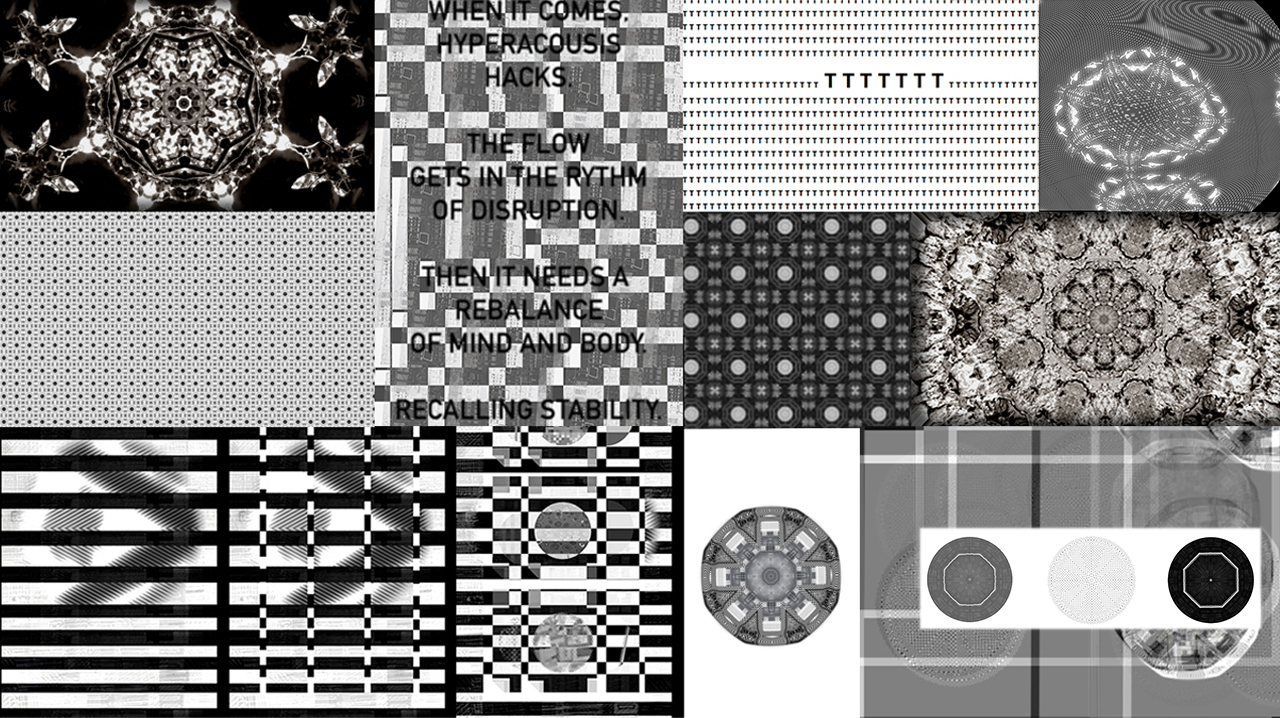Art-Essay by Luca M. Damiani
Introduction / Overview
The work presented in this art-essay is a hybrid format of artwork, case-study and diary reflection. Here I share auto-ethnographic data1 based on my acoustic condition of bilateral hyperacusis (both pain and vestibular type) and bilateral severe tinnitus.2 I started to suffer from these auditory disorders in January 2018 while working as a Digital Producer. Due to some faulty audio equipment, a large set of speakers blew right behind where I was standing, exposing me to an incredibly high level sound blast. I then began a variety of therapies, heard other people’s experiences through support organizations and networks,3,4,5 and I then started to have more treatments, as well as using technologies available from hearing aids (they have been a lifesaver for my tinnitus and hidden hearing loss) to the various different sound-filters and noisecancelling headphones for the hyperacusis when out (but without over-protecting),6 sound therapies, mindfulness techniques and psychotherapy.7

But hyperacusis has impacted my quality of life in every way—it is very difficult to tolerate sounds in the everyday, even those sounds that seem completely normal and un-noticeable to others. My everyday life, my work, home, relationships, financial and social lives have all been affected especially because it has made it very difficult to function in different situations outside of my own home (because of the pain and vertigo caused by environment sounds), and living in a city and urban environment (in my case London) became intolerable. I started to have overwhelming sensations of cloudiness and discomfort in an urban space, and after around seven–eight months I moved to the English seaside. Also, my artistic practice and work (which included workshops, events, festivals, installations, traveling) has been massively impacted, and my teaching job at university was very difficult to continue. I then began in earnest, as much as my new found high levels of fatigue and low concentration would allow, to investigate the conditions from home, trying to reframe this situation (both personally and professionally); I find the analytical and experimental approach of my art-academic practice helpful in this difficult process and difficult period of my life.
As part of the cognitive behaviour therapeutic (CBT) programmes that I follow for the acoustic trauma, I collect info and notes each day. This becomes also part of the parallel auto-ethnographic observation I am developing in relation to the condition, connecting to my practice as a media artist and academic. The collected data (i.e. trigger-response to sound, track-tools numerical outputs, diagram, written emotions, diary notes) creates patterns of ethnographic data that I can then analyze in relation to what the sensorial disorder brings up in my daily process. I also start to consider its impact on my neurodivergent condition of Asperger’s (high functioning, ASD), which I was already investigating within the art&design discipline.8,9
Being analytical in the ethnographic processing of the cognitive responses, in this piece not only do I explore the acoustic-neurological condition, but I also experiment with creative methods for the ethnographic processing and analysis. Here I share an evolving development from a poem, to graphics, to visual podcast.
Forthcoming posts in this creative sequence:
- Visualizing my Acoustic Condition: Hyper Sensorial Neuro Response (Poem)
- Visualizing my Acoustic Condition: Graphic Poem
- Visualizing my Acoustic Condition: Hyper Sensorial, Visual Graphic Poem
- Exploring Hyperacusis: Ethno-Graphic Podcast
References
[1] Chang H. (2009) Autoethnography as Method (Developing Qualitative Inquiry). Routledge.
[2] McKenna L., Baguley D., McFerran D. (2010) Living with Tinnitus and Hyperacusis. Sheldon Press.
[3] British Tinnitus Association <https://www.tinnitus.org.uk/>.
[4] American Tinnitus Association <https://www.ata.org/>.
[5] Hyperacusis Network <http://www.hyperacusis.net/>.
[6] Mraz N. and Folmer R. (2003) Overprotection in Hyperacusis-Phonophobia & Tinnitus Retraining Therapy. Audiology Online.
[7] Sadlier M., Stephens S., Kennedy V. (2008) Tinnitus Rehabilitation: a mindfulness meditation cognitive behavioural therapy.
[8] Damiani L. (2017) Art, Design & Neurodiversity. Electronic Visualisation and the Arts, BCS.
[9] Damiani L. (2018) On the Spectrum within Art&Design Academic Practice. UAL Spark Journal, Vol. 3.